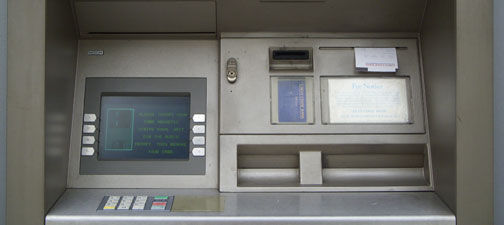 Considering that the user of most drive-thru ATMs is a driver, it strikes the weasel as odd that there are Braille dots scattered across these ATMs keypads. The answer may be more simple that we imagined. After all, those dots aren’t just there to massage your fingers.
Considering that the user of most drive-thru ATMs is a driver, it strikes the weasel as odd that there are Braille dots scattered across these ATMs keypads. The answer may be more simple that we imagined. After all, those dots aren’t just there to massage your fingers.
Why There is Braille on Drive-Thru ATMs
There are two primary explanations for the use of Braille on ATMs. First and foremost, ATM manufacturers already include Braille on their walk-up ATMs to service blind clientele. Certainly it is more economical to produce all ATMs with the same parts, including the same Braille covered buttons and keypads. As we know, money makes the world go ’round. Beyond economics, it is also the case that there are some federal laws at play. Braille is required by law in the American with Disabilities Act (ADA), specifically section 4.34.4 of the ADA Accessibility Guidelines for Buildings and Facilities. Yes, ATMs – both drive-thru and non – are categorically called out in the document. And yes, the blind also use drive-thru ATMs. Consider the visually impaired as a taxicab passenger, unwilling to trust the driver for assistance with personal information and access to their bank accounts – and rightfully so. But this still begs yet another more pressing question.
How Do the Visually Impaired Even Use an ATM?
Whether an ATM’s keypad is labelled with Braille or not, there is no requirement for a Braille translation for the on-screen instructions on an ATM, rendering the mandatory keypad and consequently the ATM useless for the blind user. Should you take the time to review the guiding federal legislation of the ADA as the weasel has, you may find that the accessibility guidelines are almost decisively vague. That is no mistake. When the guidelines were originally written, neither the banks nor the government had a feasible proposal for making ATMs universally blind-user-friendly. Make no mistake, there were plenty of proposals, but none were written into law. So the decision was made to defer further detail in the legislation and leave the rules hazy until someone could find a solution. These days, many of the newer ATMs utilize one of two solutions to this problem. Some ATMs include an additional block of Braille instructions that provide the visually impaired user with directions for completing basic transactions. As would be expected, the instructions must be read carefully and followed to a tee to avoid issues. There will also always be the concern that the Braille instructions may not be kept up to date with the machine’s software. Another solution we’ve seen is the Braille-marked headphone jack that allows the user to privately access audio instructions and prompts for use of the ATM. Though perhaps a better solution, it still requires the user to carry a set of headphones. Have you seen a clever fix to this surprisingly difficult issue? Share in the comments below! For more detailed information on the ADA and a good way to induce sleep, click here. Or for more fun information, click here instead. Learn something new!

This is one awesome article.Thanks Again. Much obliged.